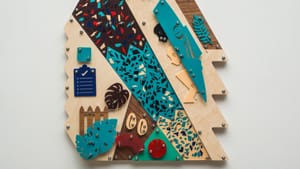Stay in the Loop
BSR publishes on a weekly schedule, with an email newsletter every Wednesday and Thursday morning. There’s no paywall, and subscribing is always free.
Unpacking Damien Davis's 'Color Cargo'

Icons always simplify. Whether it’s the Apple logo or a winking emoji, these shapes serve as visual shorthand for larger ideas. Thoughtlessly consumed and universally understood, their meaning is one-to-one.
But what happens when people with vastly different lives encounter the same shapes? Can visual universality withstand the diversity of experience?
That question, and how it pertains to racial politics, resounds through Damien Davis’s Color Cargo at the Center For Art in Wood. The exhibition’s deceptively smooth icons—from masks and lips to school buses and on/off symbols—communicate a different meaning each time they appear in this brightly colored, tightly arranged exhibition of collage and sculpture.
Nothing is universal
Says Davis, “There’s no such thing as a universality when it comes to experiencing art… Any sort of system or structure that’s trying to assert that everything can be experienced in some kind of default, universal way I see as wrong or problematic.”
One role of Color Cargo, he says, is to create opportunities for “slippage,” intentional muddying of the viewers’ basic understandings of image, language, and race.
Take, for example, the moor head.
This simple neck-up profile of a Black male is perhaps the most present shape in Color Cargo. Taken from the flag of the Italian isle of Sardinia, the facial outline has historically served as an aesthetic flourish on many European family crests.
“In the same way that someone might have a horse or a tiger on their family crest, they’ll have, like, the head of a Black person,” Davis shares with unsurprised bemusement.
A less familiar image in the United States, the head plays a variety of roles in Color Cargo: sometimes wearing a football helmet or mask, sometimes bare, sometimes leading a procession of darker-colored heads across the collage.
What's on your mind?
The exhibition explores visual dehumanization beyond these historically animal treatments. Other images carry messages of objectification—loose teeth, anuses, and disembodied female torsos address the reduction of Blackness to commercial, sexual, and emotional currency.
This dwindling of Black humanity to its parts continues in the brightly crafted crates that scatter the floor of Color Cargo. Dedicated in part to Henry “Box” Brown—a man who achieved freedom from slavery by literally mailing himself to Philadelphia—these colorful boxes of varied shape appear at first playful; Davis even calls them “candy.” Their context, however, invites the viewer to imagine how the human form might contort into these bright containers.
Racial iconography’s slippery nature strongly informs the shapes Davis works with. Some icons are too obvious, others nearly too personal. He was particularly reluctant to use the pattern of a basketball, which appears on only two of his collages.
“I have a really complicated relationship with that shape,” he says. Growing up larger than most children his age, Davis’s size and race resulted in constant social pressure to play sports. This push to physical performance, Davis says, overlooked his childhood intellect, interests, and artistic talent.
“[People were] constantly telling me that the only thing I’ll ever be good for is bouncing a ball around,” Davis says. “My life’s mission became to prove everyone wrong.”
This lifelong zeal for subverting expectations of Blackness also informs Davis’s methods. The shapes in Color Cargo are all computer-rendered with mathematical precision. They intentionally shatter stereotypes of Black artistry as primal, raw, or primitive—descriptions Davis found all too typical during his time in art school.
“It’s important for me to signal a way of working or making work that… can occupy all these spaces that Black people historically have been told that they aren’t supposed to go,” he says.
Damien Davis: Color Cargo is now open and runs through July 20, 2019, at the Center for Art in Wood, 141 North 3rd Street.
Sign up for our newsletter
All of the week's new articles, all in one place. Sign up for the free weekly BSR newsletters, and don't miss a conversation.

 Scotty Meiser
Scotty Meiser